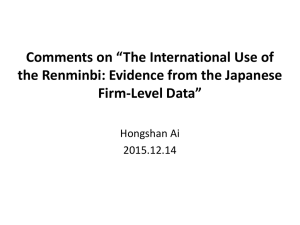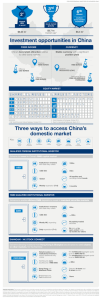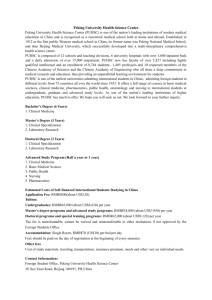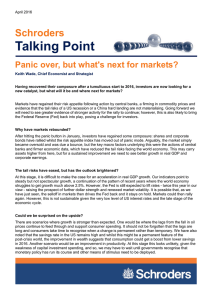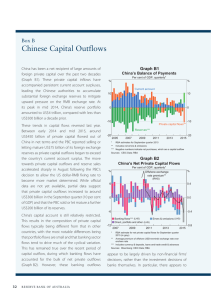Talking Point Schroders Heading for number yuan: the growth of RMB bonds
advertisement
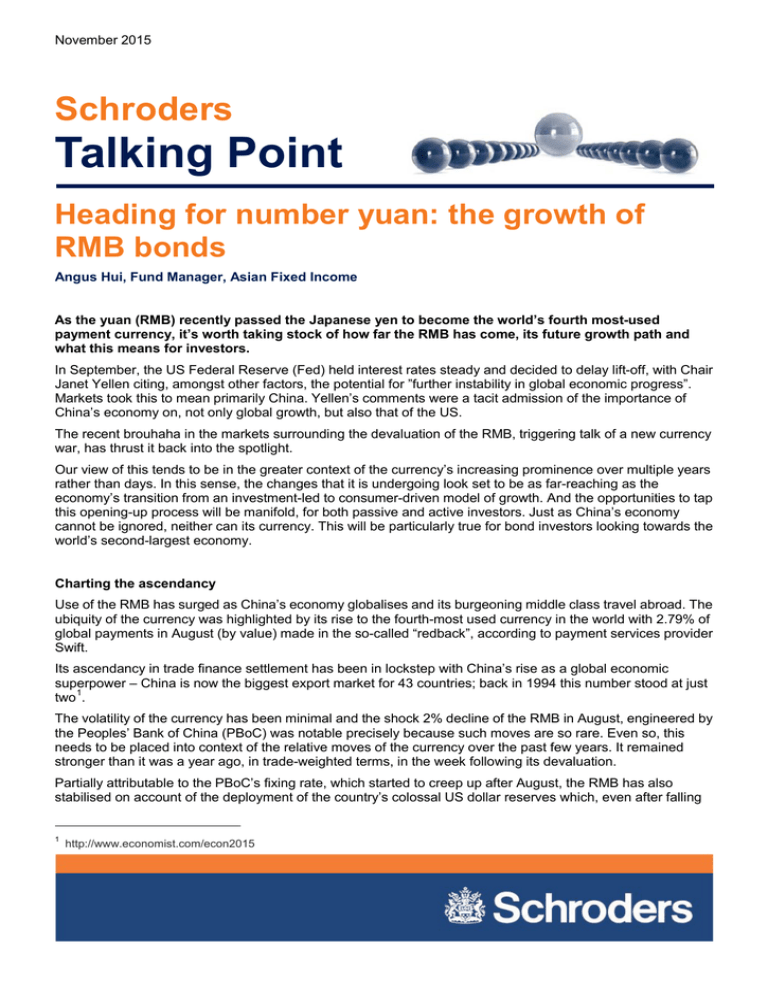
November 2015 Schroders Talking Point Heading for number yuan: the growth of RMB bonds Angus Hui, Fund Manager, Asian Fixed Income As the yuan (RMB) recently passed the Japanese yen to become the world’s fourth most-used payment currency, it’s worth taking stock of how far the RMB has come, its future growth path and what this means for investors. In September, the US Federal Reserve (Fed) held interest rates steady and decided to delay lift-off, with Chair Janet Yellen citing, amongst other factors, the potential for ”further instability in global economic progress”. Markets took this to mean primarily China. Yellen’s comments were a tacit admission of the importance of China’s economy on, not only global growth, but also that of the US. The recent brouhaha in the markets surrounding the devaluation of the RMB, triggering talk of a new currency war, has thrust it back into the spotlight. Our view of this tends to be in the greater context of the currency’s increasing prominence over multiple years rather than days. In this sense, the changes that it is undergoing look set to be as far-reaching as the economy’s transition from an investment-led to consumer-driven model of growth. And the opportunities to tap this opening-up process will be manifold, for both passive and active investors. Just as China’s economy cannot be ignored, neither can its currency. This will be particularly true for bond investors looking towards the world’s second-largest economy. Charting the ascendancy Use of the RMB has surged as China’s economy globalises and its burgeoning middle class travel abroad. The ubiquity of the currency was highlighted by its rise to the fourth-most used currency in the world with 2.79% of global payments in August (by value) made in the so-called “redback”, according to payment services provider Swift. Its ascendancy in trade finance settlement has been in lockstep with China’s rise as a global economic superpower – China is now the biggest export market for 43 countries; back in 1994 this number stood at just two 1. The volatility of the currency has been minimal and the shock 2% decline of the RMB in August, engineered by the Peoples’ Bank of China (PBoC) was notable precisely because such moves are so rare. Even so, this needs to be placed into context of the relative moves of the currency over the past few years. It remained stronger than it was a year ago, in trade-weighted terms, in the week following its devaluation. Partially attributable to the PBoC’s fixing rate, which started to creep up after August, the RMB has also stabilised on account of the deployment of the country’s colossal US dollar reserves which, even after falling 1 http://www.economist.com/econ2015 SchrodersTalking Point Page 2 12% since reaching a peak of $4 trillion, still stand at $3.51 trillion. We view its recent devaluation as part of the broader reform of the currency and offshore RMB liquidity continues to remain stable. Even after the PBoC’s surprise devaluation of the RMB, deposits in both Hong Kong and Taiwan – two key offshore trading centres for the currency – remained stable and there were no significant withdrawals. This scramble for a piece of the growing RMB payments pie has seen Hong Kong’s importance, as the primary destination as an offshore centre, diminish. However, that has been a positive development. Multiple cities have announced deals to be offshore dealing centres, which should continue to propel the currency’s use and accessibility. Too big to ignore It comes as no surprise that China’s burgeoning RMB bond market has been growing in prominence, in tandem with the currency. The key questions are how investors can benefit from this transition and where we believe the best opportunities lie, in what is a fast-growing market. The government bond market in China is the third-largest in the world, by market capitalisation. And it’s not only the government debt market that has been growing. Corporates in China are starting to turn to the bond market to raise financing and this extends beyond the country’s renowned property sector. Although property developers themselves are typically perceived to share similar credit profiles, this couldn’t be further from the truth. Many have much stronger fundamentals and are an attractive proposition on a risk-adjusted basis. Any veritably diversified portfolio can no longer rule out RMB assets as part of its composition. For investors, this is going to be a huge shift, albeit one that also offers opportunities. Monetary policy in China still offers scope for the PBoC to cut rates. The latest rate cuts, announced in August, only saw the one-year lending rate slashed to 4.6%. Spreads over ultra-low yields found in the West is evident in that even RMB investment grade (IG) credits are yielding over 4%. Uncertain global conditions China will continue to benefit from lower oil and commodity prices. This will lower input costs and also bolster China’s current account. In this sort of environment, we foresee longer duration bonds continuing to do well and expect high quality corporate issuers in China to outperform. The effects of this drop in commodity prices are positive for China’s current account balance while being negative for inflation. These are all bond-positive factors for investors and, in an environment where a strengthening US dollar is wreaking havoc on many emerging market currencies, the RMB has been relatively sheltered from this onslaught. Uncertainty surrounding global growth provides further impetus to investors to take RMB bonds as a strategic long-term proposition. The on-going process of opening up China’s capital account will also see investors become more aware of the various benefits RMB bonds can offer for the long-term investor. Important Information Any security(s) mentioned above is for illustrative purpose only, not a recommendation to invest or divest. This document is intended to be for information purposes only and it is not intended as promotional material in any respect. The views and opinions contained herein are those of the author(s), and do not necessarily represent views expressed or reflected in other Schroders communications, strategies or funds. The material is not intended to provide, and should not be relied on for investment advice or recommendation. Opinions stated are matters of judgment, which may change. Information herein is SchrodersTalking Point Page 3 believed to be reliable, but Schroder Investment Management (Hong Kong) Limited does not warrant its completeness or accuracy. Investment involves risks. Past performance and any forecasts are not necessarily a guide to future or likely performance. You should remember that the value of investments can go down as well as up and is not guaranteed. Exchange rate changes may cause the value of the overseas investments to rise or fall. For risks associated with investment in securities in emerging and less developed markets, please refer to the relevant offering document. The information contained in this document is provided for information purpose only and does not constitute any solicitation and offering of investment products. Potential investors should be aware that such investments involve market risk and should be regarded as long-term investments. Derivatives carry a high degree of risk and should only be considered by sophisticated investors. This material, including the website, has not been reviewed by the SFC. Issued by Schroder Investment Management (Hong Kong) Limited. Schroder Investment Management (Hong Kong) Limited Level 33, Two Pacific Place, 88 Queensway, Hong Kong Telephone +852 2521 1633 Fax +852 2530 9095
